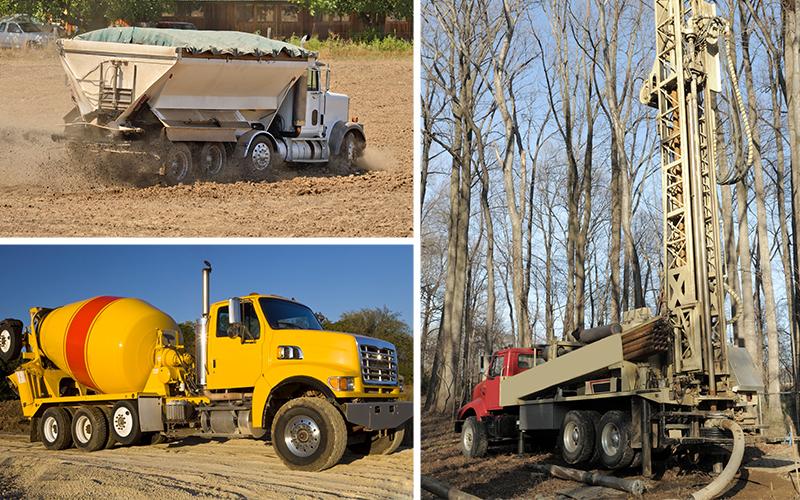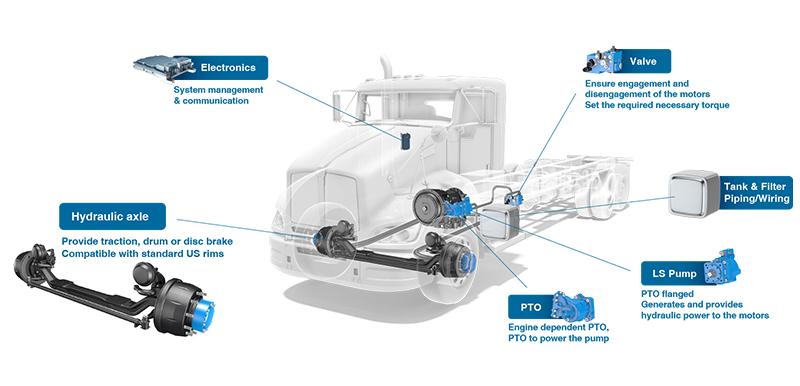New AddiDrive™ Solution Dedicated To The US Truck Market
Maximizing productivity and safety while minimizing CO2 emissions is a top priority in many industries. For companies that use trucks, the challenges they face include maximizing payload, uptime, and material lifetime while minimizing fuel consumption. Add to these challenges recent supply chain constraints all over the U.S. and diminishing spare-part inventories. With all-wheel-drive trucks, finding the right compromise for the job and route is paramount to ensuring a truck gets the job done effectively.
The most popular trucks on the market today are those for on-road applications such as long-haul trucking. These trucks are optimized for driving on the road but not for rough terrains, as they do not normally operate off-road. On the other hand, mechanical AWD versions are perfect off-road but offer limited onroad performance. Having only these two alternatives presents a problem for vocational application truck users who spend nearly all their time on-road and only a small amount of it off-road. They are based either on a standard long-haul truck that can get stuck in offroad conditions, or, if based on a mechanical AWD transmission, they limit their on-road performance.
Mechanical AWD truck constraints
Mechanical AWD is a solution for high mobility needs and short-distance driving. It is optimal for trucks working almost exclusively off-road. To avoid risk to mobility in this type of application, a common solution is to acquire a mechanical AWD truck that copes with difficult situations with or without load, maximizing uptime. However, mechanical AWD has constraints, such as a reduced turning radius, which dramatically limits maneuverability.
Furthermore, AWD necessitates increased ride height, creating constraints when driving on-road. This is especially limiting when it comes to height restrictions on bridges and tunnels, and even more so for utility trucks with over-cab lifts or cranes already at the limit of height regulations. Moreover, mechanical AWD reduces the payload and increases fuel consumption, which makes it not suitable for driving on-road most of time. This makes AWD inappropriate for trucks in applications such as fire and rescue, construction, towing and recovery, or other specialized hauling applications.

On-demand AWD AddiDrive™ hydraulic system's benefits
A compromise for these types of applications, the best of both worlds, so to speak, is an on-demand AWD hydraulic system that has the capability of a standard truck in off-road situations but maintains its on-road performance. This type of solution delivers optimal mobility in difficult driving conditions, such as mud, snow, slope, or sand, improving maneuverability by keeping a standard turning radius and improving the grip on unstable terrains or in low-adherence situations.
With Poclain Hydraulics’ on-demand hydraulic AWD system AddiDrive™, there is no need to increase the cab height; the axle fits perfectly with standard chassis integration, which means the same ride height as a standard truck. Having traction in the front wheels does not affect the installation of auxiliaries or truck-height compliance for road regulations.

Minimal impact on payload and fuel consumption
The system has minimal impact on payload and fuel consumption. A truck with the AddiDrive™ system can carry up to 1,400 pounds more than a standard truck with AWD. Fuel consumption with the AddiDrive™ system increases by only 0,5-1% while a mechanical AWD increases fuel consumption by 10-15%. The system increases tire lifetime by avoiding excess slippage. It also lowers total cost of ownership because of reductions in downtime, maintenance, fuel consumption, and tire wear. It boosts productivity by maximizing the daily payload and offering better comfort and safety for the driver.
From a driver’s perspective, keeping the same cabin height as a standard truck improves comfort and optimizes the driver’s visibility and ergonomic accessibility. The system also reduces stress and driver fatigue and provides peace of mind that they will meet their mileage goals. Additionally, on-demand hydraulic AWD, through increased mobility without added height, reduces the planning required of fleet managers and drivers by optimizing routes and driving hours. Even when drivers encounter harsh weather conditions or irregular terrain such as fields, forests, or construction sites, they will not get stuck or lose valuable time.

Besides advantages to end users, an on-demand hydraulic AWD system has a positive impact on the environment. Reduced slippage increases tire lifetime, which reduces waste and fuel consumption, thus limiting emissions. It also means there may be no need to pave access to the work site. Additionally, the system reduces the risk of cash spent for towing a stuck truck, which is beneficial to fleet managers, drivers, and the environment. By keeping the same fifth-wheel height as a standard truck, the manager can standardize his fleet of trailers.
On-demand hydraulic AWD system architecture is relatively simple. The new AddiDrive™ open loop system optimized for U.S. trucks consists of a load-sensing-type pump, a valve, an electronic control unit, and two motors assembled onto an axle that is fitted inside the truck’s wheels. Besides these components, the system requires a hydraulic tank, a filtration system, pipes and wiring to complete the system.
Compatible with North American standards for North American trucks
For system integration, the system must be compatible with North American standards for North American trucks. In the new AddiDrive™ open loop system, the motors are tailored to fit U.S. standard rims, while the axle covers a full range of load capacity. The pump is compact and the tank is easy to integrate without taking up space needed for other components. Thus the system fits trucks from class 6 up to class 8. Moreover, the system is compatible with U.S. truck power take-offs. Allowing mounting of the pump directly onto a transmission PTO makes for a compact and optimized integration that does not interfere with work done by the bodybuilders and upfitters, making it fully compatible with their tools. At speeds up to12 mph, where increased traction is often needed, the system is able to provide 5,000 lbf tractive effort at 5,100 psi (351 bar).
AddiDrive™ is a simple set-up
AddiDrive™ is a simple set-up. When the system is activated, the pump, powered by the transmission PTO, generates and provides flow to the valve block, which ensures safety and manages the motors’ activation. The valve block splits the flow between the two motors, providing traction. The electronic control manages communication and pilots the system. Contrary to a mechanical axle, on-demand hydraulic AWD delivers torque only at the required level and only when needed. The driver maneuvers a switch on the dashboard, activating the system and allowing it to engage and disengage. In AddiDrive™ systems, engagement and disengagement can be done on-the-fly, while the vehicle is moving.
On-demand hydraulic AWD has two modes:
- Traction mode, in which the hydraulic-powered axle delivers torque
- Freewheeling mode, in which the two hydraulic motors are disengaged
Traction mode vs Freewheeling mode
In traction mode, the AddiDrive™ system can drive the truck up to 12 mph, after which it automatically disengages. Depending on the resistance created by the machine to move, maximum pressure may be applied in the hydraulic motors to provide around 5,000 lbf additional tractive effort. Maximum torque can be applied from 0 mph; afterward it will be adapted at higher speed, never exceeding maximum power limitation.
Maximum tractive effort is optimized depending on the front-axle load and low-traction conditions typically encountered in difficult situations. While the traction mode is active, the pump displacement is controlled to ensure speed synchronization between the front and rear wheels. Additionally, the driver can adjust the pump displacement to the required level of system pressure. When the system is disengaged, the pump returns to the neutral position and the two motors switch to freewheeling mode, reducing system drag losses to a minimum.
Efficient performance
Generally, integration for this type of system occurs at the OEM level. It offers OEMs an opportunity to differentiate their product. OEMs can deliver more versatile truck models with efficient performance both on- and off-road without the constraints of a mechanical AWD. The front axle is fully equipped with a plug-and-play solution compatible with the chassis installed on the normal axle; only the hoses need to be attached. This type of plug-and-play system offers fast integration at the OEM level, requiring less resources.
When specifying a truck AWD solution, the work and application need to be carefully examined. Whether a work truck is destined for full or partial off-road driving needs to be analyzed carefully to optimize the total cost of ownership and deliver a right-sized solution for each application. Having a choice between full-time and on-demand hydraulic solutions allows OEMs and fleets to differentiate themselves further in the market.
Bruno Lacheteau
AddiDrive™ Program Manager
Poclain Hydraulics
Contact us https://poclain-hydraulics.com/contact-us
Meet us at Conexpo, Las Vegas, 14-18 March, 2023


